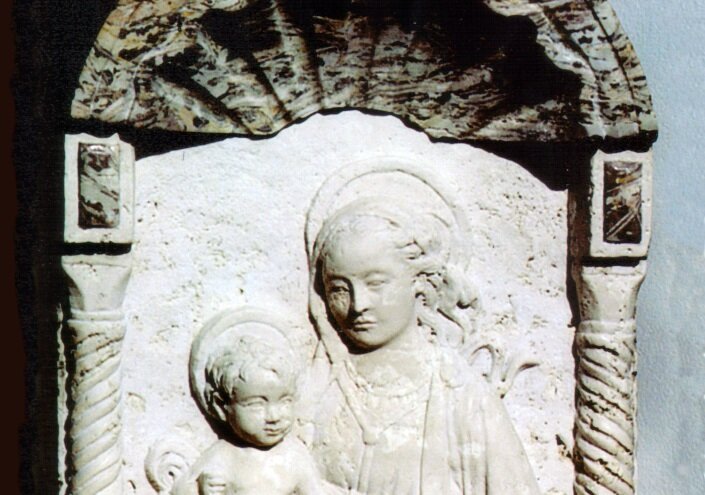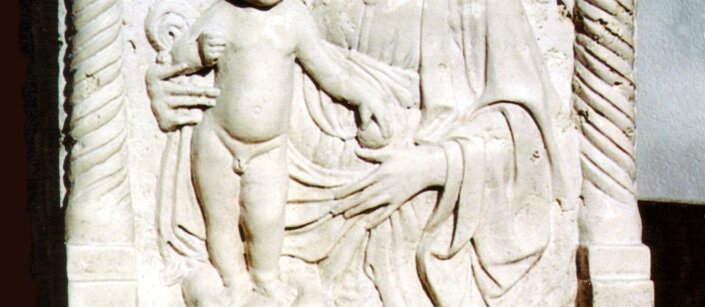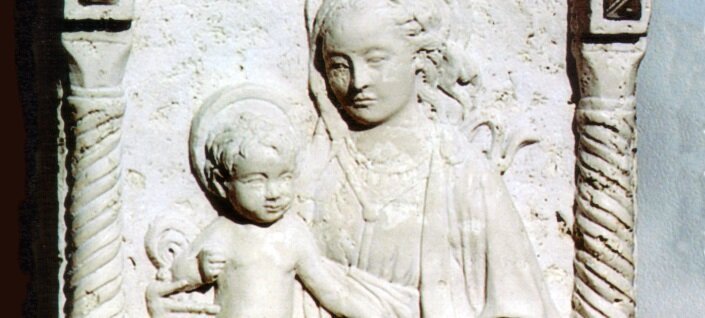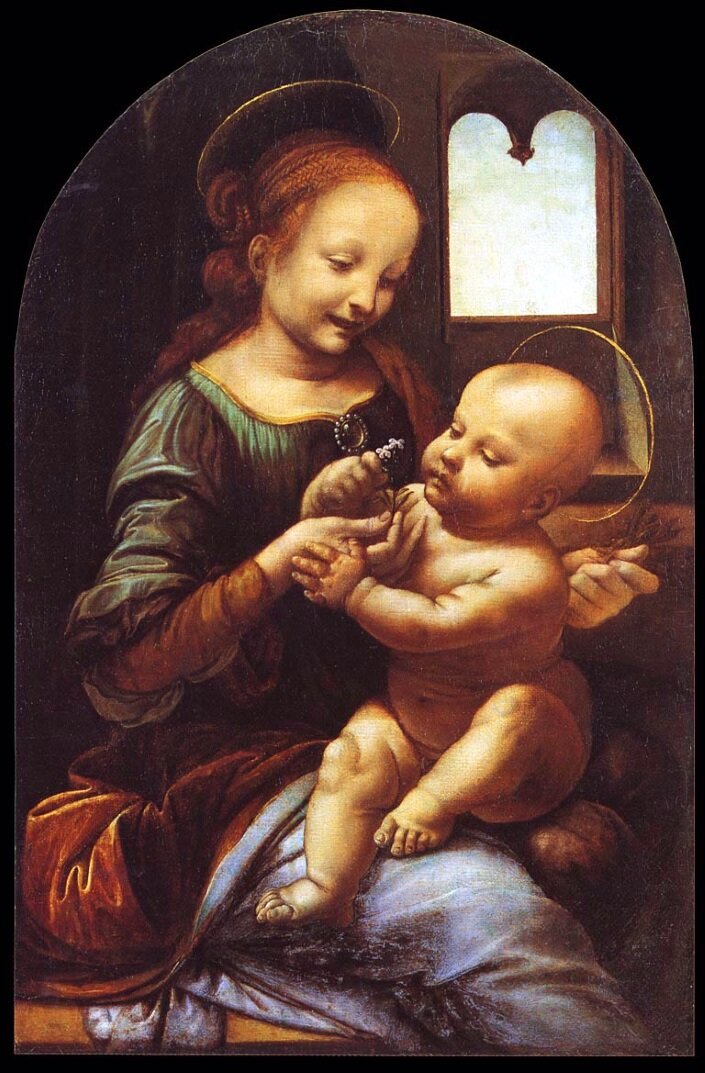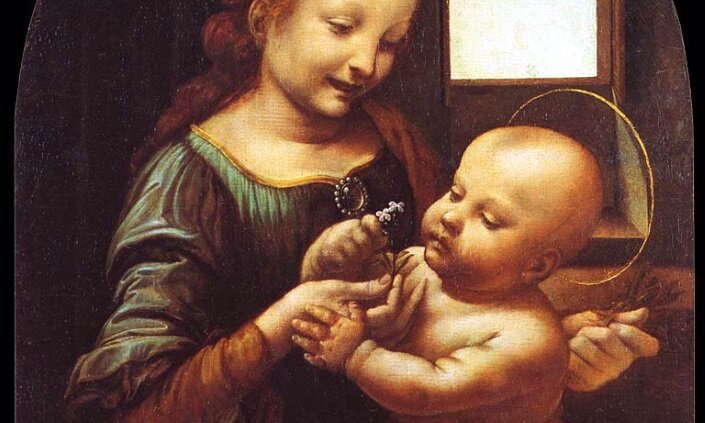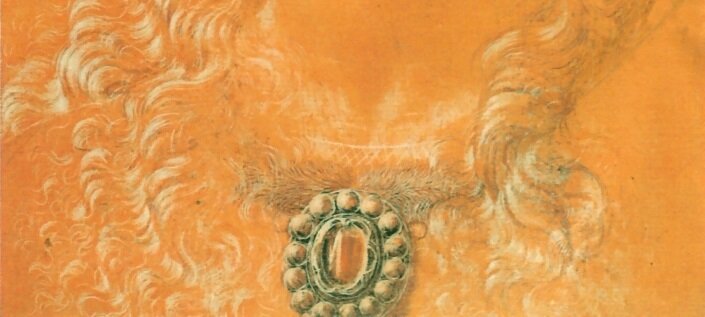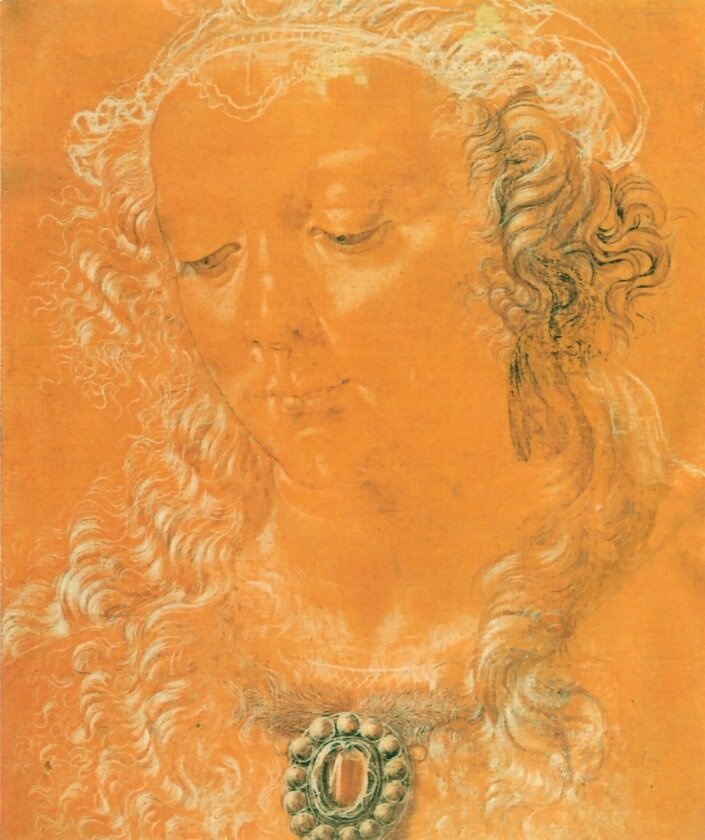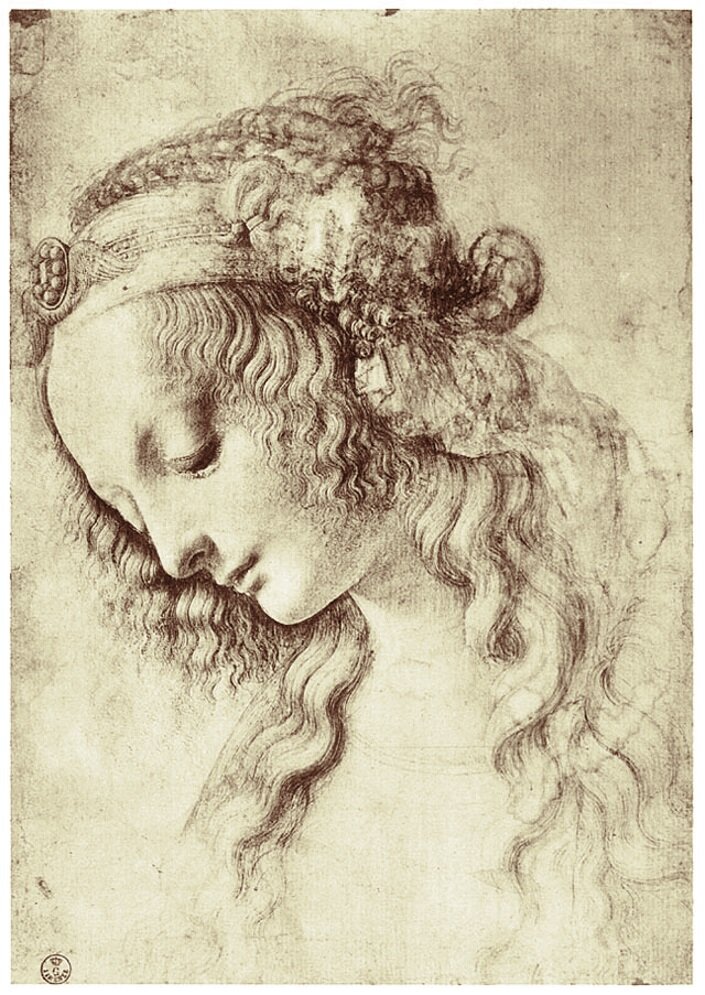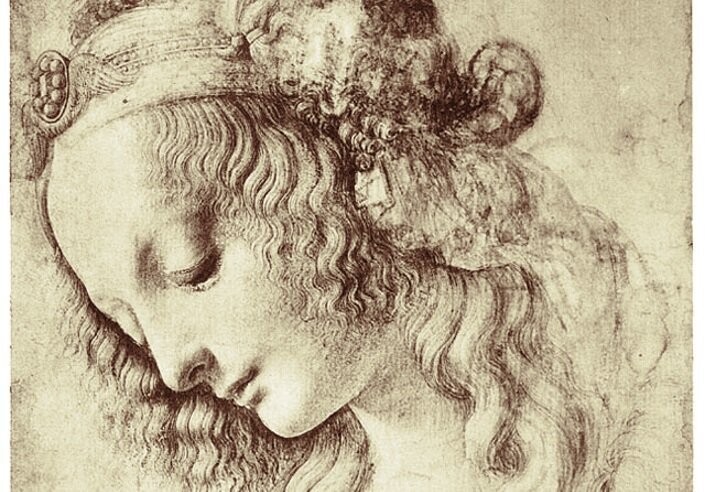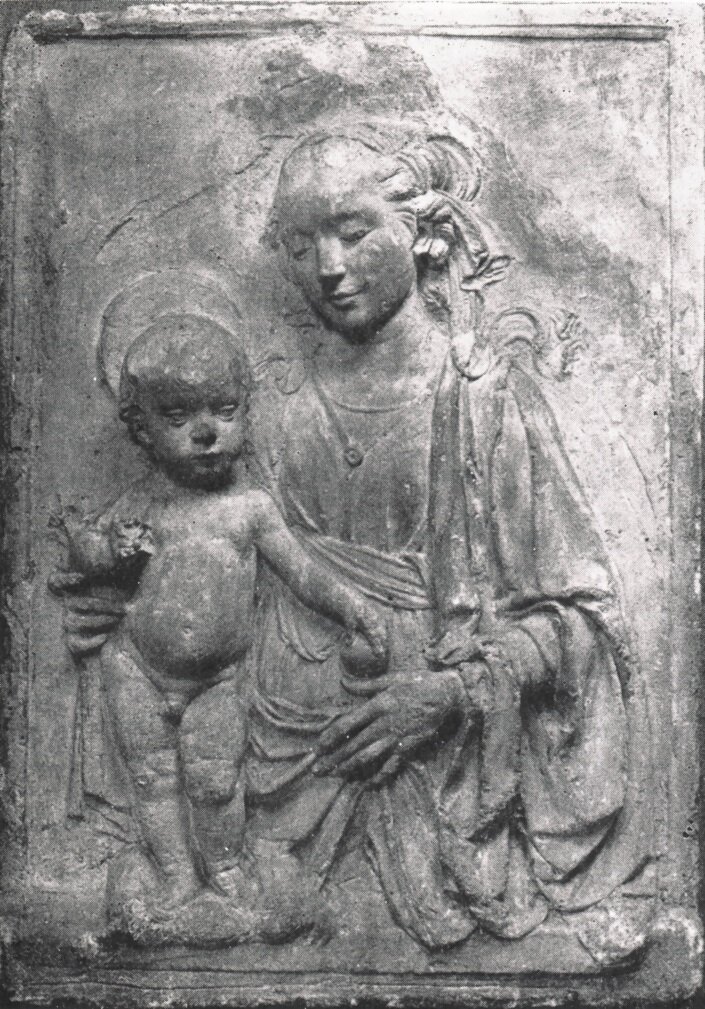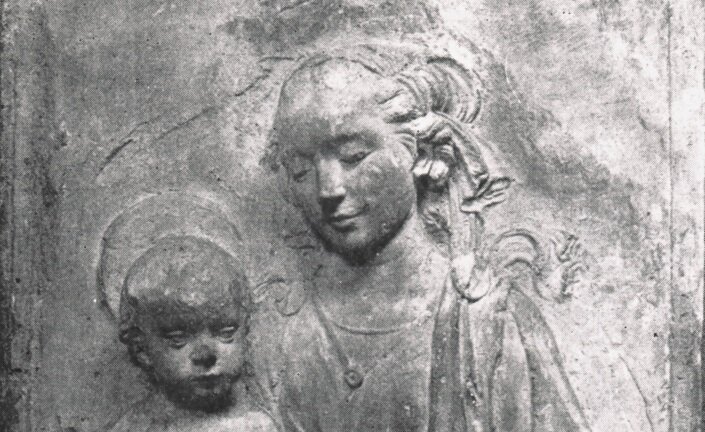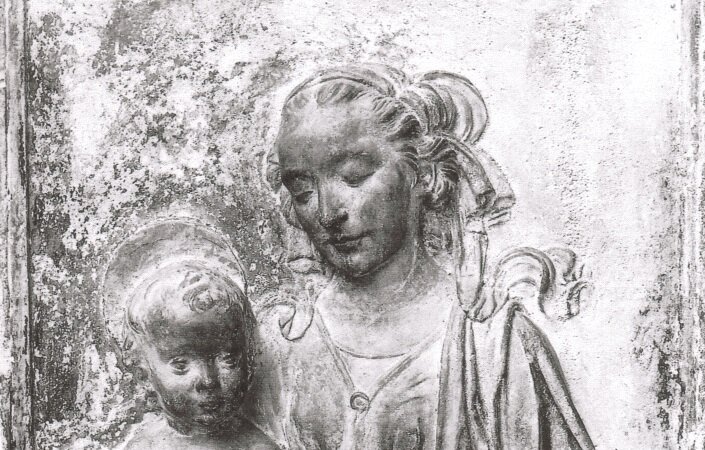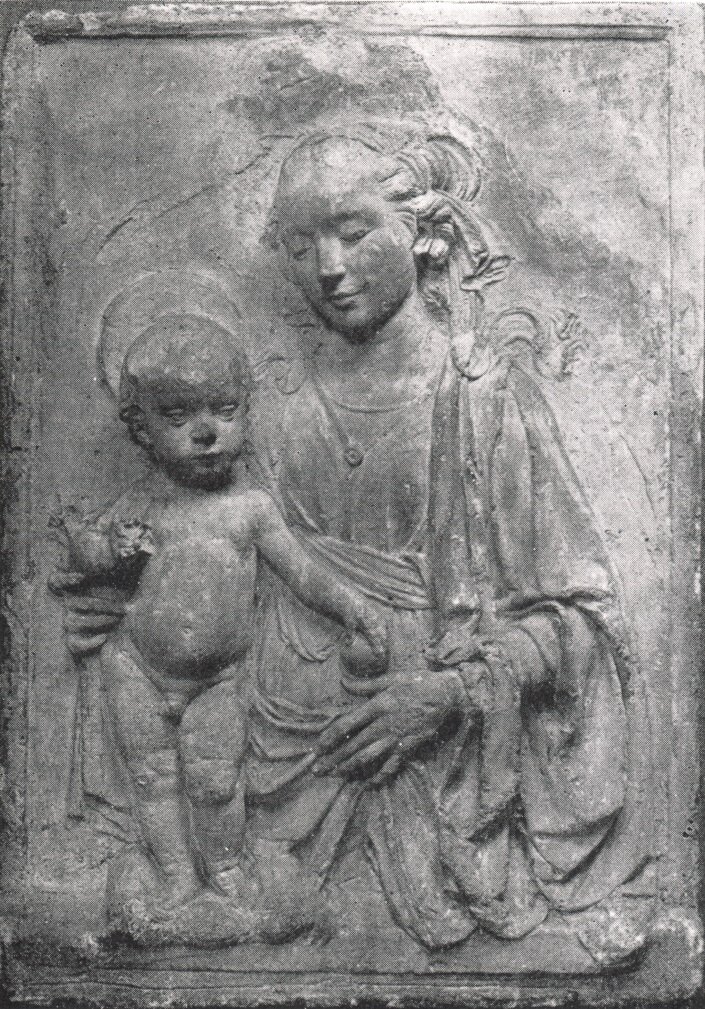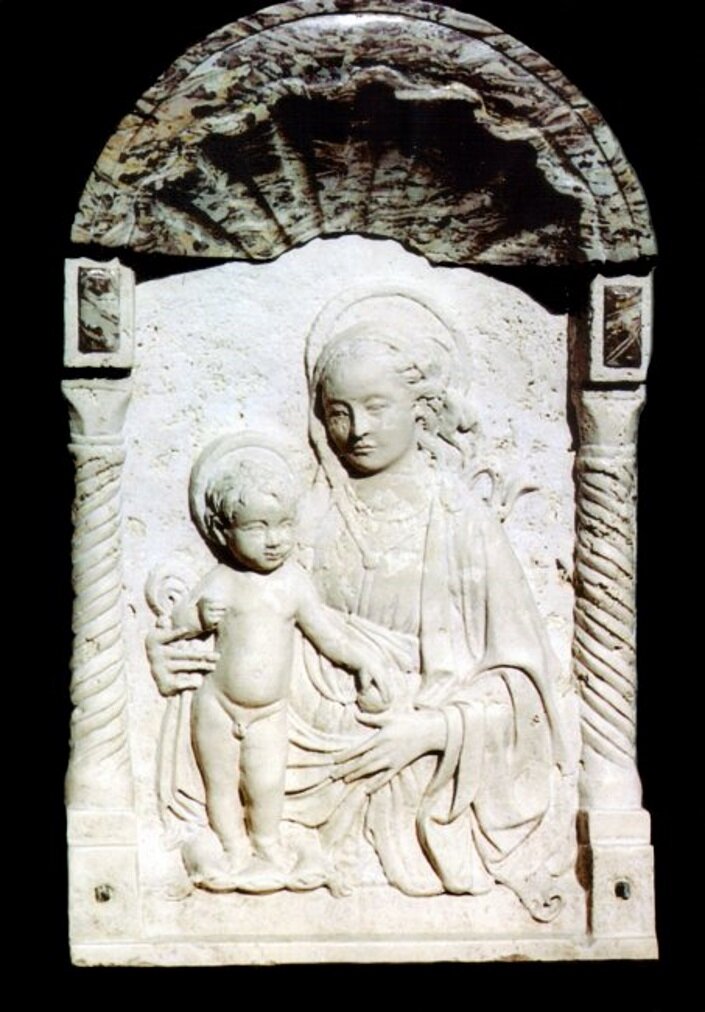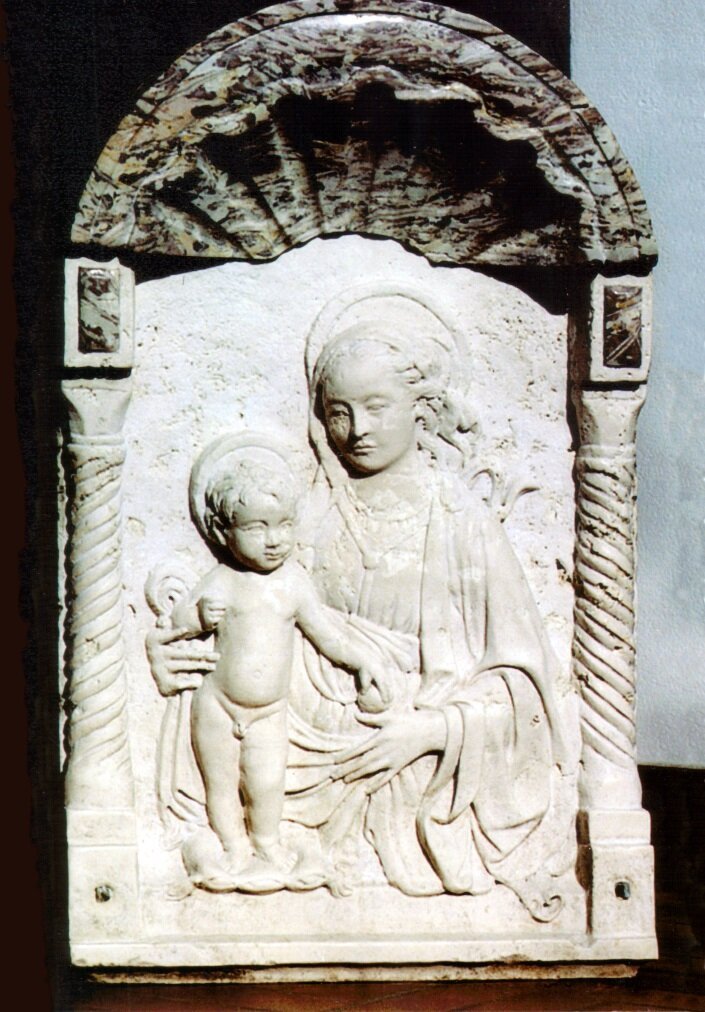
For more info on this argument send an e-mail at info(at)leonardoscultore.com
Leonardo sculptor ?
Hypothesis, thesis & development ...
Thesis
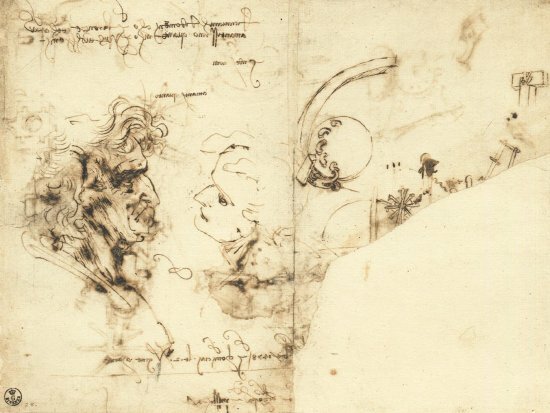
Written works attributed to Leonardo
1.- from the Gabinetto dei Disegni e delle Stampe at the Uffizi Gallery, Florence with ink pen on paper 20.2 x 26.6 …… in the autumn of 1478 “j chominciaj le 2 V rgine Marie….e chopa j pisstoja….” (no. 446 Uffizi Gallery, Florence) It is known that Verrocchio moved his laboratory to Pistoia in 1477/78 where his pupil Lorenzo di Credi completed a commissioned sculpture. (T.Cook, chap.V) 2.- a declaration of Leonardo himself confirms that in Verrocchio’s laboratory he familiarised himself with stone sculpturing, and, in his “A Treatise on Painting” (sheet 34), that he exerted himself “no less in sculpture than in painting, and carried out either works with the same degree”, and yet again…”Therefore, he who wishes to learn…should practise creating relief figures, in marble or stone, or in plaster…”.(from “A Treatise on Painting”).
Later written works
Based on the book about Verrocchio dated 1904 pg. 123, Maud Cruttwell attributes picture C.4 to the hand of Francesco di Simone Ferrucci comparing the rectangular-shaped plaster of Paris (dim: 59.6 x 84) with Verrocchio’s style, as did Passavant subsequently. Moreover he added the use of the same mould for at least a second identical replica in stucco (C.5 dim. 60.3 x 84) also rectangular in shape, which John Pope-Hennessy in Revue de l’Art 80, 1988 pg. 15-25 agreed to, confirming them both to be Verrocchio style as based on a prototype which had gone missing (not rectangular, however, as we shall see). Sir Theodore Cook did not agree to this theory, according to his two books dated 1919 and 1923, which became subject of an in-depth analysis on behalf of the Da Vinci commission chaired by the famous Adolfo Venturi. He attributed the stucco in plaster of Paris (C.4) to the hand of Leonardo da Vinci, claiming, with evident difficulty, that it was “a sculpture”, also named the Signa Madonna after the name of the neighbouring area outside Florence where in 1897 Mr. Dibble had purchased it, from the owners at that time, at the Albizzi’s Villa Sant’Ilario near Lastra a Signa in Florence. A photograph was published by Field on 29.11.1913 attributing the work to Leonardo. Cook sustained that the imminent marriage of his daughter Giovanna Albizzi to Lorenzo Tornabuoni had driven the mother of the beautiful Giovanna to purchase the sculpture of the Sacred Image from Verrocchio’s Laboratory and to expose it outside of the young woman’s window when she awoke. The Signa Madonna, an Essay in Comparisons, by Sir Theodore Cook, printed by the Field Press LTD, Windors House, LONDON December 1919. Leonardo da Vinci Sculptor, LONDON Arthur L. Humphreys 1923.
Development
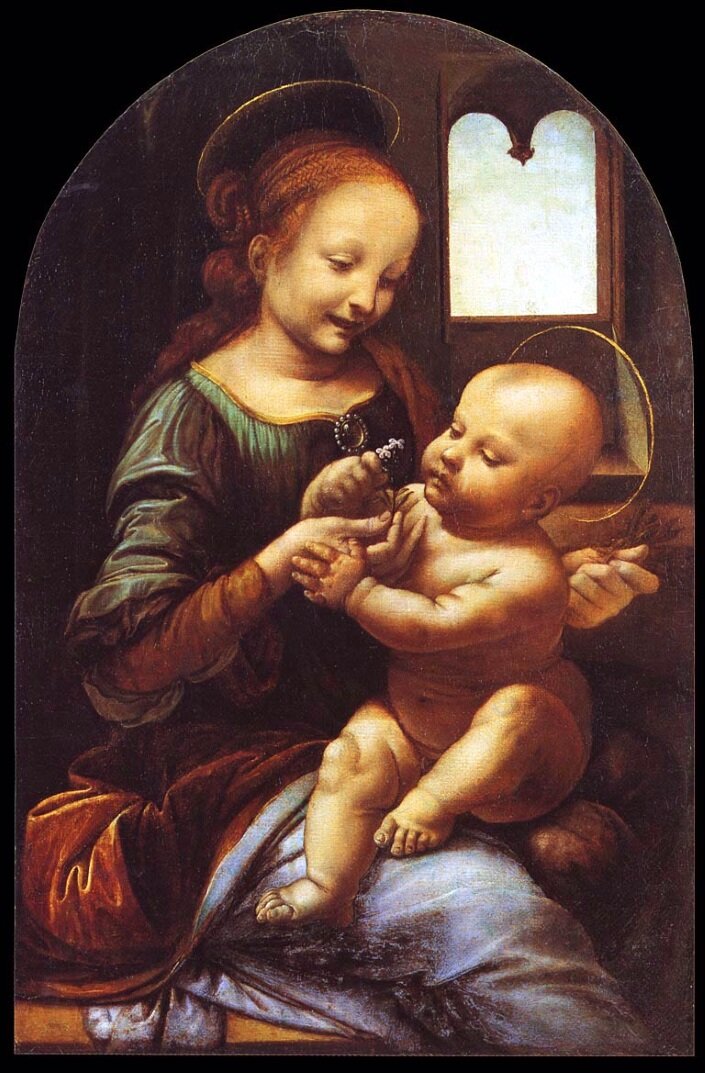
Catalogued photographic image of the “Benois Madonna” painting at the Hermitage Museum, St Petersburg.
The Benois Madonna at the Hermitage Museum was definitively attributed to Leonardo in 1909 and recognised due to one of the two figures of the Virgin Mary started in 1478. It was an oil on panel, transferred to canvas 31 x 48. Thus, this occurred before Sir Theodore Andrea Cook “christened” his Madonna and Child (C.4) as one of the two works mentioned in the writings at the Uffizi Gallery in Florence. Strangely the English writer makes no mention of having recognised the painting at St Petersburg! He was clearly uninformed, otherwise he would have compared them and a surprising “mirror-like” similarity would have emerged.
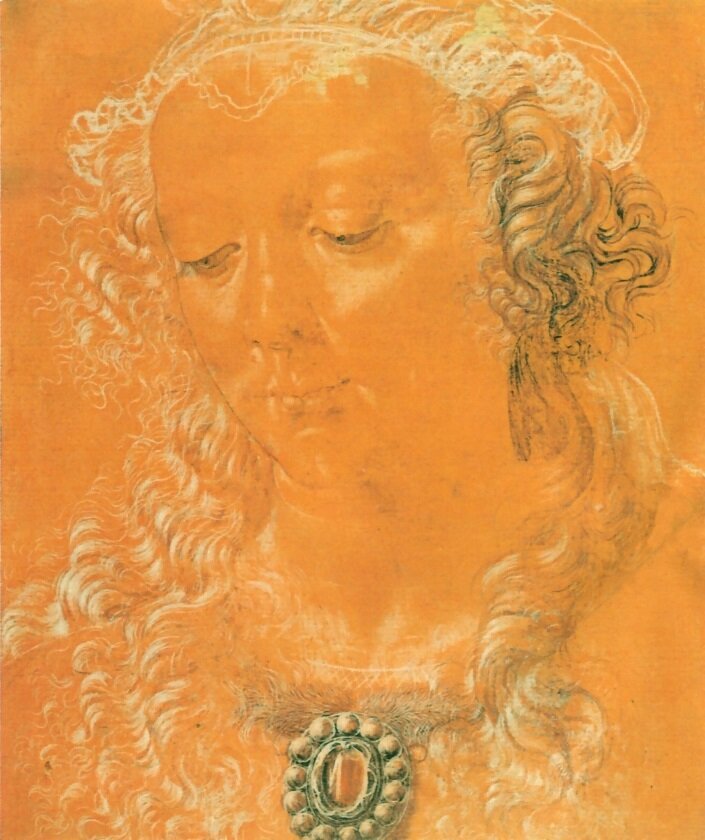
Catalogued photographic image of the Woman’s head etched on coloured paper at the Louvre Museum, Paris ( inv. 18965 ).
Previously catalogued at the Louvre among the anonymous German authors of the XVI Century, this etching on coloured paper in metalpoint, pen and black and grey ink, with grey watercolours, heightening, orange red paper 268x223 mm, stone medal and pearl necklace, which Suida attributes to Leonardo in 1929, is at present shared by Gigetta Dalli Regoli. She also expresses her difficulty in attributing the study of the Louvre to either Andrea or to Leonardo, however in her opinion, it is closely related to other works of the latter, and above all to the famous Divine Head at the Gabinetto Disegni e Stampe degli Uffizi (inv. 428E), an authentic Da Vinci. The veil pinned to the temples and covering the forehead, later added to the first version, could possibly be separated.
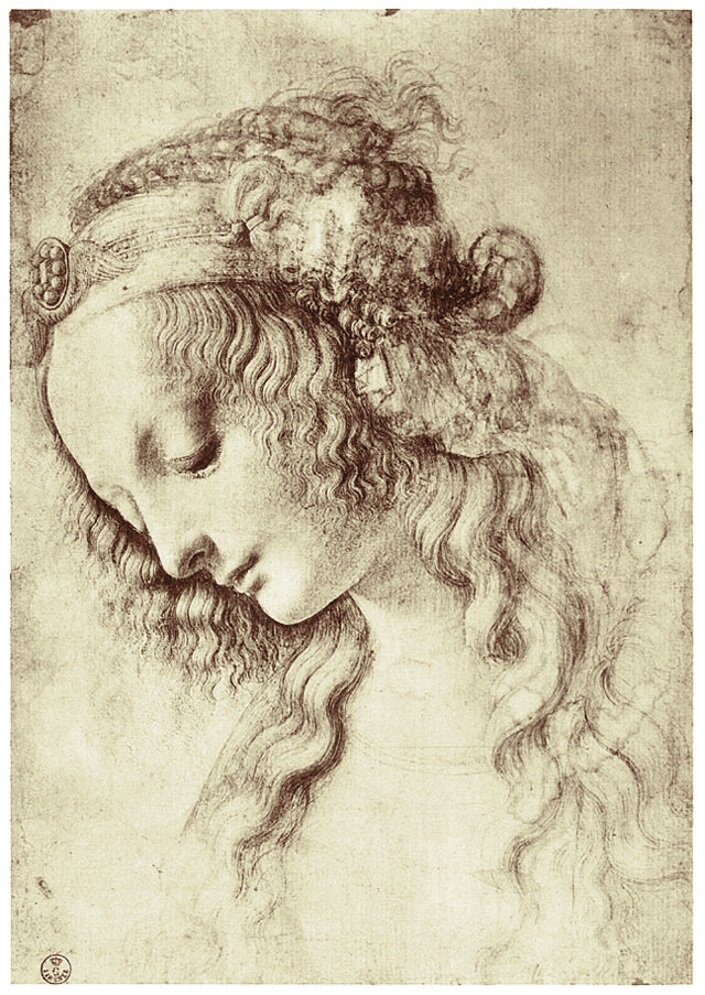
Catalogued photographic image in metalpoint, pen feather, watercolour white pigment on white paper dim. 281 x 199 (inv. 428 E) at the Gabinetto Disegni e Stampe in the Uffizi Gallery, Florence, Divine Head.
Similar to the previous, with the face bent more towards the right and downwards while maintaining the eyes and eyelids cast downwards towards the ground, the long hair gathered at the nape of the neck and partially left loose and with the stone medal and pearls on the forehead instead of round the neck, is unanimously attributed to Leonardo da Vinci.

Unpublished photographic image of the Eighteenth-century Venetian sculpture portraying the Madonna and Child on a single block of pink marble.
The unpublished sculpture emerging from the antiques market with dim. 60 x 91, has two lateral “wings” which integrate the single block surely with the aim of “enclosing” the sculpture both on the right and on the left. We may easily imagine that whomever copied, since this is definitely a copy, and consequently enclosed it, also used clamps which instead were not present. The style used is typically Eighteenth-century, Venetian, covered with flowers and softened while maintaining a perfect similarity both in the religious aspect and in the architectural outline, except for the frontal part. Both a visual but also an historical reference point, it represents the will of its client who commissioned the sculptor to go before the original masterpiece and gather the inspiration and personalisation of a replica with great appeal and with the utmost consideration of the incomparable Maestro. Initial research, which however requires further examination and study, collocates this work at the middle of the Eighteenth century, when the Cardinal-presbyter in Padua was Carlo della Torre Rezzonico, nominated by Pope Clement XII in 1737. In 1758 Cardinal Rezzonico became Pope Clement XIII. However, his family, of Venetian origin, and of Lombard origin before that, owned a summer residence named Villa Rezzonico near the banks of the river Adige in Sant’Urbano, Padua. It was in this very palace that the sculpture was kept, also this one being a copy of the previous mould C.4 and C.5.

Catalogued photographic image of the stucco at the Allen Memorial Art Museum of the Oberlin College /Ohio.
Previously already considered moulds or copies, they may however be compared to the above mentioned Woman’s Head (C.2) noticing the complete similarity in the regular features, the bent face, the lowered eyelids, the wavy hair.
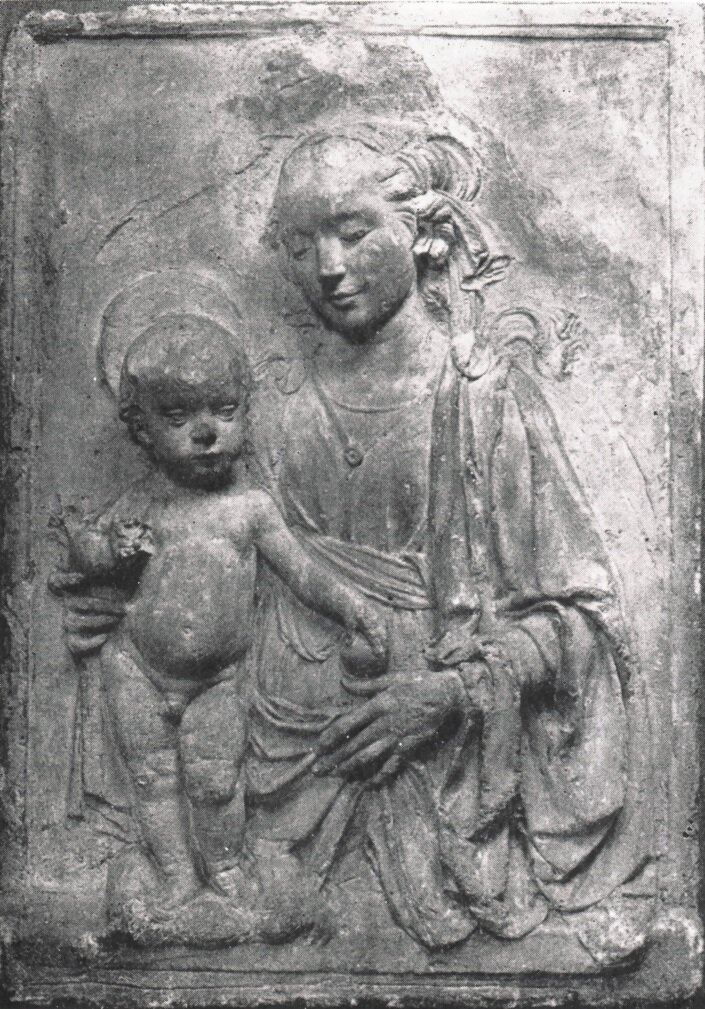
Catalogued photographic image of the Madonna and Child in “plastering with so-called plaster of Paris” formerly at the Ashmolean Museum in Oxford, then Mr.G.B. Dibble, at present in London.
One can note the peculiar presence of a small bird on the right hand of the Child, not present in the other comparisons, and the simultaneous absence of the halo on the Madonna as in the following work.

Unpublished photographic image of a sculpture as per subject.
Magnificent, an altarpiece form like the Benois Madonna, measuring 60 x 97 cm, evidencing classic Sixteenth-century Tuscany Renaissance features (see Orsanmichele Florence). The relief is embellished with marble inlays, is slightly damaged on the face of the Madonna but the purity of her left hand which “comes alive” shows incomparable craftsmanship.
Considering the various and crossed comparisons in a succession of “challenges” on the religious theme of the Madonna and Child carried out in various manners by the major artists in the brief but intense late Fifth-century Florence, one cannot risk supposing that apart from the painting, also a sculpture, subsequently “moulded”, could have challenged maestro Verrocchio, Della Robbia and many others, remaining the “testata d’angolo” to refer to until the Nineteenth century to then fall into oblivion, perhaps completed. We could therefore imagine that:
a.- in …ber of 1478 he began two works of the Virgin Mary
b.- I was young and wished to test myself in everything. So I thought of simultaneously creating two sister-like artistic forms of expression, painting and sculpture. I needed a model, and so I etched the face of the Madonna on coloured paper just as I wished it to be sculptured. I had always liked colours and for this reason I then adorned the white stone with pink marble inlays.
c.- the stone, humble and aged, was very hard but with the stiacciato I rubbed down the shadows even though, in the end, I preferred the softer and free paintbrush.
d.- the “sezione aurea” helped me choose the dimensions, one being the half of the other.
e.- in the painting, perhaps to play on the enigma, I added light from behind with an open double lancet window to show how the light of faith itself, just as open praying hands, emerge one from the right and the other from the left, either smiling or solemn, Madonna and Child with Haloes.
f.- I no longer recall, but I think I left them incomplete and that Lorenzo and Francesco completed them since I had to leave for Florence. Stuccoes were done but not with an altarpiece and even less so with Maternal Halo.
D. My signature was the usual stone medal and pearl necklace.
Leonardo sculptor ?
Hypothesis, thesis & development ...
Where ?
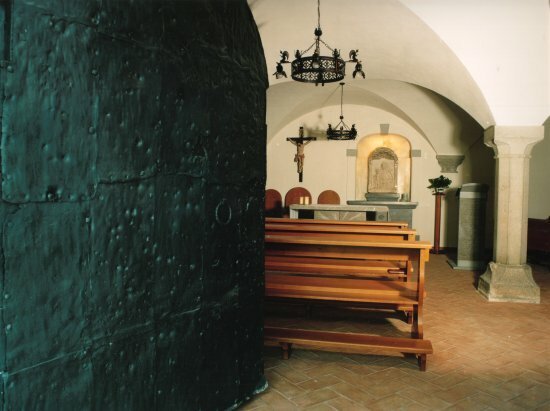
Cappella Monastero Totus Tuus delle Clarisse
P.zza Sant' Antonio - Gorizia ( GO ) - Italy

